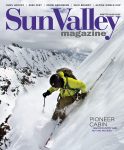Cruising to Roundhouse Gondola, where a tour of the famous Bald Mountain snowmaking system would begin at 11am, I was halted by a fence, a bulldozer and a muddy trench. “There’s a water leak in a pipe between those two snow guns,” pointed out Tom Boley of Sun Valley Guest Services, as we watched the machine’s claw dip underground. Others had stopped too, uncertain as to why their snowy escape had become a construction site, understandably ignorant of the infrastructure behind the Sun Valley experience.
Dennis Harper, Sun Valley’s Snowmaking Manager, and his crew of 16 snowmakers, on the other hand, operate and maintain daily the miles of pipe that lie beneath the groomed runs. Whoever was digging up River Run knew exactly what they were doing—and I was about to find out.
Snowmaking at Sun Valley has long been the wizard behind the curtain, but only in recent years has the department gotten the publicity it deserves. Offered for the first time last season, the snowmaking tours reflect a public shift in attention to the resort’s air and water operations. The focus can partially be attributed to the spectre of global warming hovering over the weather-dependent ski industry. With climate forecasters predicting increased variability in Idaho’s snowfall over the coming decades, snowmaking will be as crucial as ever to opening Sun Valley—and keeping it ski-able. At the same time, Baldy’s 550-gun setup is such a marvel of engineering that it almost necessitates a tour, regardless of what effect climate change will have on natural snowfall and the anticipated escalation of artificial snow production in years to come.
“We like to brag that this is the largest automated system in North America,” beamed Harper, sitting across from me in the gondola. Added Ben Siefart, the tour’s only other member: “And the second biggest is Snowbasin,” (which, like Baldy, is also owned by the Sinclair Corporation). Siefart is a field operations manager for MY NEIGE, a subsidiary of TechnoAlpin, the world’s largest supplier of automated snowmaking systems. Neither of them are engineers and Siefart is 26. But Harper spent 25 years as a farmer in southern Idaho, surrounded by machinery, and he has spent the last 15 as a snowmaker in Sun Valley. And while only in his twenties, Siefart has been in the industry for a decade and during our tour proved to be a whip-smart snowmaking nerd, if there ever was one.
“The question I get asked the most,” said Harper, “is where I got my engineering degree to run this thing. When I say I don’t have one, people ask, ‘Are any of you guys engineers?’” His response: “Nope, we’re just ski bums and farmers.” When the big dig on Lower River Run finally appeared out the gondola window, I quizzed Sun Valley’s snow farmer on the leakage problem. “No biggie,” Harper shrugged. Nothing he and his crew hadn’t seen before.
From the top of the Gondola, Harper led us to Roundhouse Slope, where he stopped before a giant steel straw shielded in yellow pads: a Borax six-meter. Harped then pointed below us, at the more energy-efficient Safyr, which the department was demo-ing from MY NEIGE. The latter uses significantly less compressed air, Harper said, requiring less energy. Keeping up with the manufacturers, however, is no small task for Sun Valley, considering the scope of the department and the fact that the Borax guns still blow first-rate flakes. Further, while the Safyr gun boasts excellent energy performance, the Borax is equal (even superior) in marginal temperatures, meaning quality snowmaking even when it’s barely below freezing.
With such a diversity of “snow producers” on the market, ranging from fans to various types of internal and external mix snow guns, one can lose sight of our truest fountainhead: Mother Nature. “Nothing is as good as the natural stuff,” Harper admitted. “But when you live here in Sun Valley and you go six weeks without an inch, you definitely rely on your snowmaking. A lot of the stuff we’re doing right now isn’t totally because we need a nice surface to ski, which is the number one reason to do it, but to have enough snow come April.”
Baldy’s snowmaking tour continued inside the main control building, or CB1. Due to the leakage on River Run, the facility was hushed, its machinery dormant. Siefart and I were ushered over grates covering an on-mountain reservoir, past hanging lines of hose and around the compressors, where Harper described the passage of ambient air into CB1. It passes through the compressors and heat exchangers and, if it’s cold enough, out to the guns.
At a workstation in CB1 lay cutaways of discontinued hydrants, which Harper thoroughly dissected. We then entered the control room, which harbors three screens from which the entire network can be operated. Guns and weather stations, hundreds of sensors all “talking” to Harper, who was able to pull up live status feeds for every hydrant. “You can spin anybody’s head with this stuff,” he smiled.
Yet what Harper loves more than educating tour groups is teaching new hires the ins and outs of the job. “Snowmakers take a lot of pride in getting this stuff to run,” he said. “It’s simple in a way, once you understand it…” Sun Valley possesses North America’s largest automated snowmaking system, a complex arrangement of digital and mechanical parts — and Harper believes he can make any ski bum with the gumption a contributing part of it.
When the three of us exited CB1, Harper’s radio delivered good news from the bulldozer on River Run. “Hey, we found water! OK we’re going to go ski over and check it out.” The leak turned about to be the size of dime and easily weldable. Later, skiers would see no signs of the muddy trench, of Sun Valley’s sunken supply lines, or of Harper and his team. Getting to know Sun Valley’s snowfarmers requires an appointment, a tour, during which Harper will unbury his entire system before your eyes. No biggie.
Interesting Facts:
The Baldy snowmakers operate 555 automatic snowmaking guns, 110 weather stations, 38 miles of steel pipe, 20 water pumps and 13 air compressors. The entire system can generate 2000 gpm of River Run water, 1200 gpm of Warm Springs water, 25,000 cfm of air at 130 psi and 17,000 horsepower.
Snowmaking tours are on Baldy every Wednesday and Saturday at 11a.m. Sign up for free at the River Run Ticket Office.



